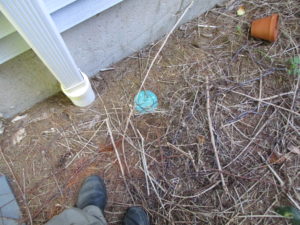Are all those buyers running away from the sale because of termites? Of course not. I would venture to say that probably less than 5% of those homes have damage that requires repairs. All termite infestation needs to be treated and once performed the home should be protected for quite some time. So how do we properly treat a home?
The preferred and most effective method of treatment is what is referred to as a “ liquid treatment”. A liquid pesticide is applied to the soil around the entire perimeter of the home. Rigid surfaces that are adjacent to or abut the home like concrete stoops and patios, driveways, walkways, etc are drilled to apply the chemical to the soil beneath and then the holes are plugged after application. This method forms a barrier around the entire perimeter of the home.
A second method of treatment is the “bait station” method.

Canisters are placed a certain intervals around the perimeter of the home. They are filled with a bait in hopes that the termite colony that is attacking your home finds one of these stations and “takes the bait”. These stations must be checked on a regular basis to determine if there is a hit. Once a station is hit, the bait is removed and the pesticide is inserted in hopes that it is taken back to the colony and distributed as was the bait. They were developed for homes that could not be safely treated because of the close proximity of a well among other complications. Pest control companies that use these systems love them because besides the cost of the initial installation or treatment, there is a charge for the regular inspections of the stations.
Overall this form of treatment is costly…it can go on and on…and can be ineffective. While we are waiting for a hit, the colony that is attacking your home is still on the war path eating your wood. And even when a strike is found, how do we know it is the colony that has infested the home, as there can be many termite colonies on a single piece of property. And, if the inspection process is stopped, so is the protection. I was once told that a home I was about to inspect was previously treated for termites. As I was performing my inspection I found no evidence of treatment. I finally had to ask the homeowner about it. He brought me out to the garage and showed me the canisters on a shelf in the garage. I asked, “What are they doing there.” He said, “ The termites are gone so I took them out of the ground”. Not good! This would not be the treatment of choice for many reason but I find it applied quite often.
As part of my inspection my clients receive a termite inspection. I will check all the “hot spots” where termites are prone to striking a home. There is one thing that I bring that I bring to the table that the average home inspector does not. I am a registered home improvement contractor and I own and operate a second business that specializes in termite damage repair. I have repaired many homes that had termite damage. Who better to make the call regarding the need and scope of repairs? Experience counts!

